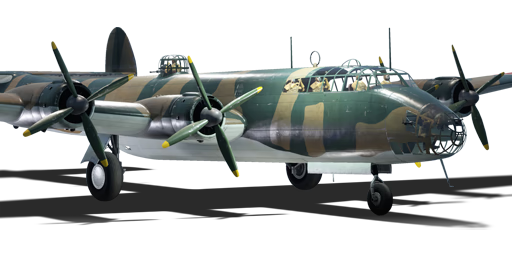



The G5N1, designated as Shinzan (深山), was a four-engine heavy bomber developed by Nakajima for the Imperial Japanese Navy before World War II. It was based on the American Douglas DC-4E airliner, which was secretly acquired and reverse-engineered by Japan in 1939. The Shinzan was intended to have a long-range capability of 3,000 nautical miles and a payload capacity of 4,000 kg of bombs or torpedoes. However, the bomber never entered service due to its poor performance, unreliable and underpowered engines.
It was introduced in Update 1.29. The G5N1 serves as one of Japan's true heavy bombers. Featuring a massive airframe and four Mitsubishi MK4B Kasei-12 fourteen-cylinder air-cooled engines, the G5N1 is easily one of the hardest planes to manoeuvre in War Thunder. It makes up for this with its large 3,200 kg payload and its incredible endurance. Since this aircraft is so large and cumbersome, its only true purpose is destroying heavy targets and bases like a true strategic bomber.
flaps
flaps
flaps
brake
| Belt | Belt filling | Armor penetration (mm) at a distance: | |||||
|---|---|---|---|---|---|---|---|
| 10 m | 100 m | 500 m | 1000 m | 1500 m | 2000 m | ||
| T/HEF/APHE | 19 | 18 | 12 | 7 | 5 | 4 | |
| HEF-T/APHE/APHE/APHE/APHE | 21 | 20 | 13 | 8 | 5 | 4 | |
| HEF/HEF-T/HEF/APHE/HEF-T | 21 | 20 | 13 | 8 | 5 | 4 | |
| Belt | Belt filling | Armor penetration (mm) at a distance: | |||||
|---|---|---|---|---|---|---|---|
| 10 m | 100 m | 500 m | 1000 m | 1500 m | 2000 m | ||
| T/IAI/Ball/AP/AP/I | 13 | 12 | 7 | 3 | 2 | 0 | |
| T/AP/AP/AP | 13 | 12 | 7 | 3 | 2 | 0 | |
| T/AP | 13 | 12 | 7 | 3 | 2 | 0 | |












Flight performance | |
|---|---|
Survivability |
|---|
Weaponry | |
|---|---|